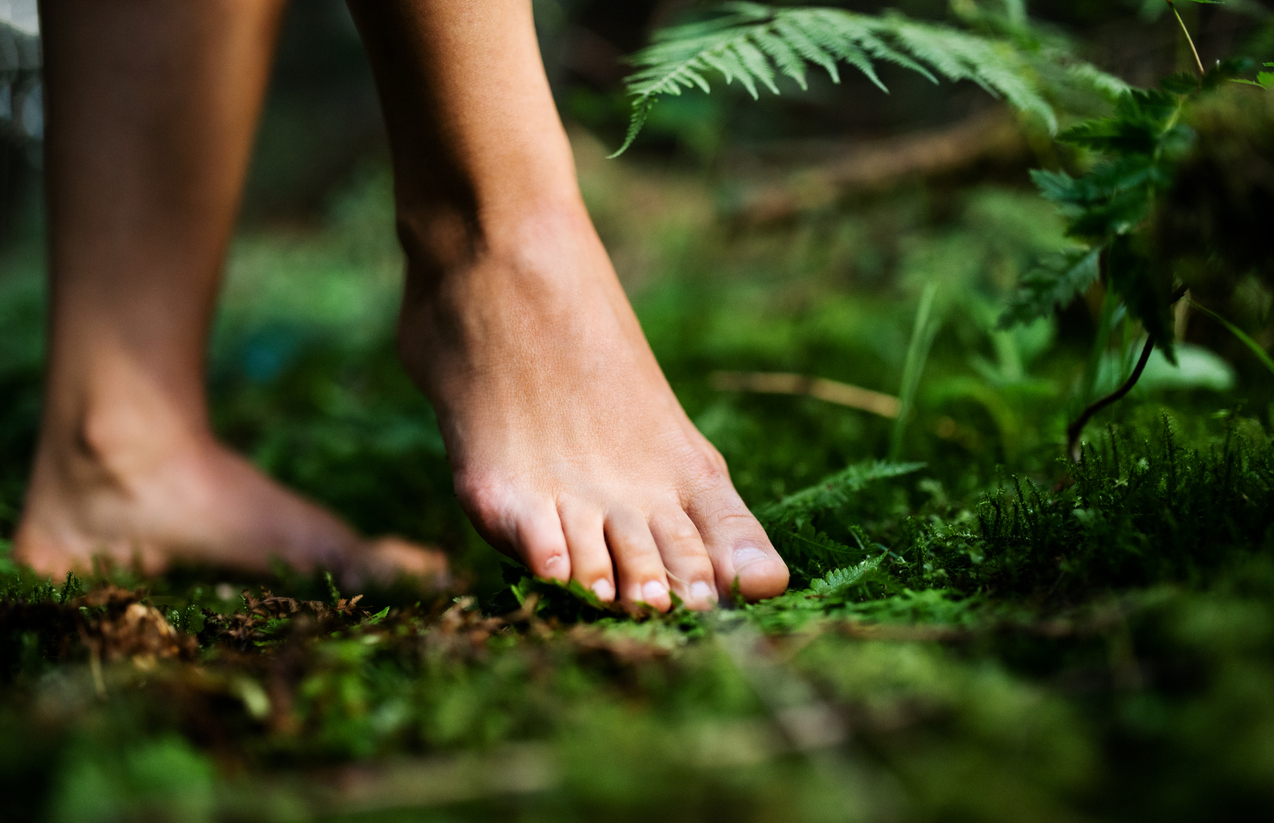Dr Emily Splichal, author of Barefoot Strong and creator of the BARE® Workout Instructor Certification encourages you to understand and experience the power of training barefoot.
The dust has settled. Gone are the days of viral debates and forums on the benefits vs risks of minimal shoes and barefoot running. Newspapers such as the New York Times have shifted their focus away from the controversy around minimal footwear and Vibram’s lawsuit is “old news”.1
With no more talk about barefoot running, does this mean that the benefits of barefoot cease to exist? And that barefoot was just a trend?
Far from it! It is finally time to shift away from the association made between the words ‘barefoot’, ‘barefoot running’ and the connotation that ‘barefoot’ is just a fad. Like foam rolling, or self-myofascial release, what started as a trend in the fitness industry is now a well-accepted, evidence-based practice that is an integral part of almost every trainer’s and client’s programme.
It is time to expand our minds, set aside any preconceptions about barefoot and take a moment to truly understand and experience the power of training – from the ground up.
As we think about the concept of barefoot training, I want you to go beyond the literal meaning of these words. This is not an argument of which shoes to wear or whether you should even be wearing shoes. Instead, what I want to focus on is the power of the human foot from a fascial and sensory perspective – and how training the foot can dramatically impact on the stability, strength and movement of our clients.
The sensory side of foot function
The human foot is a fascinating structure of 26 bones, 33 joints and more than 100 muscles, tendons and ligaments. Often appreciated for its biomechanical or kinematic role in human movement, there’s an aspect to foot function that is often under-appreciated and may arguably be more influential. This is the sensory aspect of the human foot.
The skin on the bottom of the foot is packed with special nerve endings called mechanoceptors, or tactile nerves. These nerves are sensitive to various stimuli, including pressure, texture, vibration and skin stretch, which is then used to anticipate the ground, perceive impact forces and sense shifts in our centre of gravity. Once stimulated, these sensory nerves of the feet communicate with the brain via the somatosensory cortex to paint a picture of foot and body awareness.
To optimise this interaction between the feet, ground and brain, we need to make sure we are actually feeling or ‘tuning in’ to this sensory input. One of the most common causes or reasons for the inability to sense or ‘tune in’ to the sensory input of human movement is footwear.
Thick, cushioned, supportive footwear with smooth insoles completely ‘tunes out’ the foot during dynamic movement. The excessive cushion in shoes absorbs the vibrational stimulus of impact forces, as well as other critical input that occurs at foot strike. Absorption of sensory input by shoes has demonstrated a delay in foot muscle contractions, weakening of foot muscles and delayed stability all the way up into the core and glutes.2 This can result in foot, knee or back injury, as well as a decreased performance due to delayed stabilisation.
Conversely, the stiffer, non-cushioned environment of minimal footwear and training barefoot have both been correlated with enhanced sensory stimulation, leading to hypertrophy of foot intrinsic muscles3, increased foot arch4and more efficient co-ordination between the feet and core.
From shoes to surfaces
We can take this concept of cushion, stiffness and sensory stimulation from shoes and apply it to training surfaces. The surface we train our clients on is just as important as the footwear we may recommend to them. Interestingly, when it comes to surfaces, stiffness wins again!
All surfaces are designed to vibrate and deform upon contact, with the degree of vibration being dependent on surface stiffness. A review article by Marinsek et al found that the ideal mat for optimal landing techniques in elite gymnasts was actually a stiffer mat that allowed the transmission of impact forces.5
Excessive cushion in training surfaces, such as in the case of soft mats, restricts the sensory stimulation of the foot, potentially leading to delayed stabilisation and inefficient movement patterns. When thinking about the ideal surface for your clients, you want to think that natural surfaces (wood, grass) vibrate and provide sensory stimulation more effectively than artificial surfaces (concrete, marble).
I often say that we want to think about our relationship with surfaces as symbiotic. This means that, as our foot strikes the surface, we need to vibrate but so does the surface. If, for some reason, the surface does not vibrate, there is either poor transfer of energy or excess vibration entering our foot. Both of these can lead to risk of injury.
Integration of foot stimulation in programming
The benefits of enhanced foot awareness can be applied to many aspects of fitness programming, including balance training, Olympic lifting, Pilates and conditioning. One of the most effective areas to integrate foot sensory stimulation is in the client warm-up or movement prep.
If it is conducive, you want to integrate barefoot movement on a surface that is hard and made of natural material, such as a hardwood floor. Various textures, surface densities and stimuli can be added to provide sensory variety and to train the nervous system. Textured mats such as Naboso Technology, or vibration platforms like Power Plate, both provide additional sensory stimulation to the client’s movement.
To take the power of the foot beyond just sensory stimulation, we can also incorporate specific training of foot-to-core fascial connections.
Foot-to-core fascial connections
The sensory side of the human foot is critical to dynamic movement; however, the power of the foot doesn’t end there. There is another often overlooked aspect to foot function that can be limited in footwear – foot-to-core fascial connections.
There is a powerful interconnection between the deep foot stabilisers (intrinsic muscles) and the deep core stabilisers (pelvic floor, deep rotators, etc.). This connection is via a fascial line called the deep front line, which runs from the bottom of the foot, up the lower leg and into the pelvic floor and diaphragm.
Muscles that are connected through fascial lines are designed to have co-ordinated stabilisation pathways that are fast and efficient. This speed of fascial connections is directly related to the number of sensory nerves found in fascial tissue. According to Robert Schleip, there are over 100 million sensory nerves in our myofascial web.6
During dynamic movement such as walking, the only contact point between the body and the ground is our foot; therefore, foot stability and strength is crucial to proper transfer of impact forces. When it comes to quickly and efficiently transferring these impact forces, the faster our feet and core can ‘talk’ to each other, the better our movement, the lower the risk of injury and the more efficient our gait pattern.
The way to activate and train this foot-to-core connection or the deep front line is through an exercise called short foot. Originally introduced by Dr Janda, short foot exercise has been demonstrated to effectively strength the foot intrinsics while activating the foot-to-core connection.
The video below demonstrates the proper execution of short foot exercise. Remember that the goal of this exercise is not just contracting the foot muscles but more so co-ordinating the foot contraction with the deep core and breath. I suggest incorporating this at the start of a client’s session during their barefoot sensory movement.
Video: Short foot exercise
Want to take your foot strengthening to the next level?
As the client gets stronger in their connection to the sensory and fascial side of the foot, these concepts can be integrated into all aspects of their workout. From squats to kettlebell swings, every exercise in which the foot is in contact with the ground is an opportunity to integrate sensory and fascial connections.
If being barefoot is not feasible due to the facility or client preference, then it is suggested to optimise the footwear environment. Can footwear with less cushion be used? Or can you possibly integrate a sensory insole by Naboso Technology?
The more a client can connect to their foundation, the better their overall balance, posture and gait. To learn more about the science of barefoot training, foot-to-core sequencing and fascial lines, visit ebfaglobal.com.








